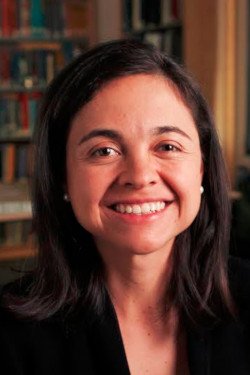Ana Maria Rey
2019 National Award Winner — Faculty

Current Position:
JILA Fellow & Professor of Physics
Institution:
University of Colorado Boulder
Discipline:
Atomic, Molecular & Optical Physics

Current Position:
JILA Fellow & Professor of Physics
Institution:
University of Colorado Boulder
Discipline:
Atomic, Molecular & Optical Physics
Recognized for: Pioneering contributions made to the field of theoretical atomic, molecular, and optical physics, including her paradigm-shifting theories on atomic collisions, which led to the development of the world’s most accurate atomic clock.
Areas of Research Interest and Expertise: Condensed Matter, Quantum Information, Many-body Physics, Quantum Optics
Biography:
Postdoctoral Fellow ITAMP-Harvard Smithsonian CFA
Postdoctoral Researcher, National Institute of Standards & Technology
PhD, Department of Physics, University of Maryland College Park
BS, Departamento de Física, Universidad de los Andes, Colombia
Research Summary:
Prof. Ana Maria Rey is a leading theoretical scientist in the field of atomic, molecular, and optical physics, who is most well-known for developing a fundamentally new understanding of atomic collisions with direct applications to timekeeping and quantum simulation. Her theory provided a paradigm shift in the precise measurements of time that led directly to the development of the world’s most accurate atomic clocks. Since joining the faculty in the Physics department and JILA (formerly Joint Institute for Laboratory Astrophysics) at the University of Colorado Boulder in 2008, Prof. Ana Maria Rey has looked to exploit and take advantage of the unique properties displayed by alkaline earth elements, such as strontium. By understanding atomic interactions between ultracold strontium atoms, Prof. Rey and colleagues were able to improve the accuracy of atomic clocks by a factor of 1000 or more over current caesium standard, which will not only advance GPS and telecommunications technologies, but will eventually produce the best-known sensors of gravity. Prof. Rey’s rich theoretical work is the intellectual driving force for her experimental collaborations with scientists both at JILA and at the National Institute of Standards and Technology (NIST), where she has also seamlessly merged the fields of atomic and molecular physics and condensed matter physics. Her research and insights in this area are leading to the synthesis of novel materials, such as topological states of matter and exotic quantum magnets, as well as a new scientific understanding of quantum phenomena out-of-equilibrium including pioneer measurements of quantum information scrambling. Prof. Ana Maria Rey’s work has pushed the boundaries of precision metrology into new territory, and is paving a pathway to help answer some of the most challenging and fundamental problems in 21st century physics
“Understanding the behavior of the microscopic quantum world is absolutely fascinating to me and actually key for technological advances. My work is addressing how to control artificial systems of ultracold atoms and light for the design of ultraprecise atomic clocks, the synthesis of exotic forms of quantum matter, the understanding of non-equilibrium many-body systems and quantum information scrambling, and also laying a foundation for future quantum computers. “
Key Publications:
A. V. Gorshkov, M. Hermele, V. Gurarie, C. Xu, P. S. Julienne, J. Ye, P. Zoller, E. Demler, M. D. Lukin, A. M. Rey. Two-orbital SU(N) magnetism with ultracold alkaline-earth atoms.Nature Physics, 2010.
M. J. Martin, M. Bishof, M. D. Swallows, X. Zhang, C. Benko, J. von-Stecher, A. V. Gorshkov, A. M. Rey, Jun Ye. A quantum many-body spin system in an optical lattice clock. Science, 2013.
S. Kolkowitz, S. L. Bromley, T. Bothwell, M. L. Wall, G. E. Marti, A. P. Koller, X. Zhang, X., A. M. Rey, J. Ye. Spin-Orbit Coupled Fermions in an Optical Lattice Clock, Nature, 2016.
M. Garttner, J. G. Bohnet, A. Safavi-Naini, M. L. Wall, J. J. Bollinger, A. M. Rey. Measuring Out-of-Time-Order Correlations and Multiple Quantum Spectra in a Trapped Ion Quantum Magnet. Nature Physics, 2017.
Other Honors
2017 Alexander Cruickshank Award in Atomic Physics
2015 Elected APS Fellow by the Topical Group Precision Measurement & Fundamental Constants
2014 Early Career National Hispanic Scientist of the Year, Museum of Science and Industry, Tampa, FL
2014 Maria Goeppert Mayer Award
2013 Presidential Early Career Award for Scientists and Engineers
2013 MacArthur Fellow, September
2013 Great Minds in STEM, “Most Promising Scientist award.”
2005 Atomic, Molecular, and Optical Physics Outstanding Doctoral Thesis Award (DAMOP thesis prize), American Physical Society
In the Media:
Universidad Nacional de Colombia, Catedra Sesquicentenario, Bogota, Colombia, (May 2017 Lecture in Spanish) Catedra Huellas que Inspiran (Footsteps that Inspire)